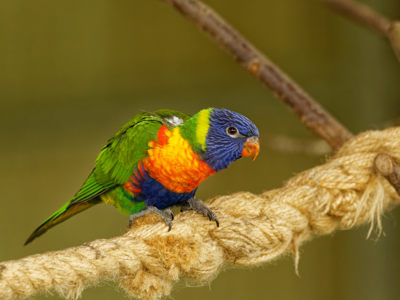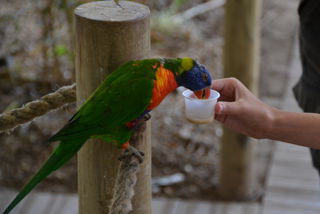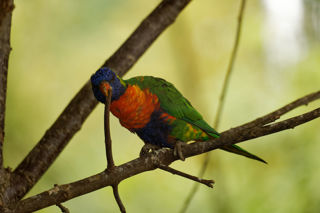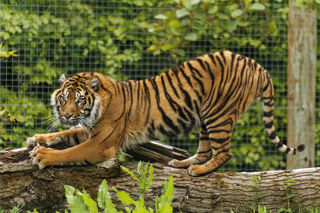
Rainbow lorikeet
Visit our Lorikeet Landing walkthrough for an amazing interactive experience with these beautiful birds, here at Twycross Zoo.
Rainbow lorikeets are medium sized, colourful birds native to Australasia. Both sexes have a very bright, multi coloured plumage. The head is a deep blue with an orange beak and red eyes. Juveniles can be spotted by their duller plumage and black beaks.

Rainbow lorikeets are classed as true parrots, as their beaks have the characteristic curved shape. Breeding can take place at various times in the year but is usually in the spring. Pairs are monogamous, keeping the same partner for life. A pair will nest in hollows or cavities in trees and will defend their nesting area aggressively. During incubation the male will bring the female food and once the chicks hatch both parents will feed them.

Rainbow lorikeets are extremely noisy birds and communicate with loud squawks. They spend most of their time feeding high up in the forest canopy, usually in pairs but sometimes in groups of hundreds. The diet of the rainbow lorikeet is made up of nectar fruit and pollen. They feed using a specially adapted tongue which has hairy spines used for soaking up their food.
Rainbow lorikeets are common and widespread throughout their range. There are no known threats to their population numbers at present. However, capture for the pet trade could become a serious threat. The continued habitat loss in their range could also become a future threat.
Key Facts:
Conservation Status: Least Concern
Distribution: Australasia
Habitat: Tropical forest & coastal
Diet: Fruit & flowers (herbivorous)
Weight: 75-157g
No. of young: 1-3

SUPPORT OUR ANIMALS
If you're looking for an alternative way to donate to Twycross Zoo, you can help support our animals and our zoo keepers by purchasing something from our Amazon Wishlist!
Updated regularly by our zoo keepers, the items on the list help to provide enrichment for our animals and keep their habitats well maintained.
Every donation helps us as a conservation charity.
